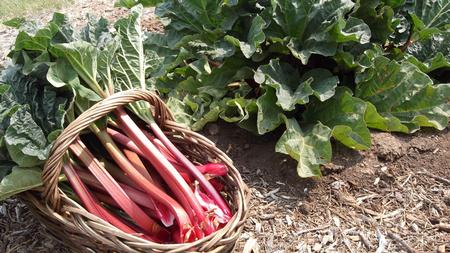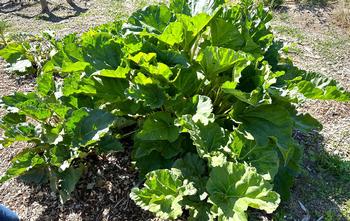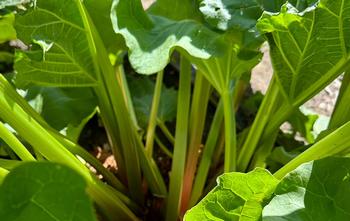News from the Edible Demo Garden
August 2023: In Praise of Rhubarb

What is Rhubarb?
Rhubarb is a vegetable that is often prepared and eaten as fruit. The leaf stalks, or petioles, are the edible part of the plant. Originating in Siberia and China, rhubarb is a member of the Polygonaceae family, a grouping of herbaceous perennial plants which also includes buckwheat and sorrel. It was first used by the Chinese for medicinal purposes but has been cultivated for its unique tart sour taste for centuries.
Nutritionally, rhubarb is an excellent source of vitamin K. It is also high in vitamin C, calcium, and antioxidants. Eaten alone, it is low in calories, but it is often combined with fruits or sweeteners to counterbalance its tartness. The classic combination is rhubarb and strawberries often mixed as a pie filling. In fact, rhubarb’s use in baking has earned it the label of “ple plant”.
Like many edible plants, rhubarb contains oxalic acid, and this may contribute to its taste. However, oxalic acid is much more highly concentrated in rhubarb leaves, and it is at a level considered to be poisonous. Only the leaf stems should be harvested for food.

Rhubarb plants are large perennials and can grow for 5 to 10 years before they need to be divided. Rhubarb also needs space. Plants typically grow 3 feet tall and up to 6 feet wide. Therefore, choosing the right place to plant it is important. Rhubarb can also double as an ornamental landscape plant, so it doesn’t need to be confined to a designated vegetable garden.
Rhubarb grows best in full sun with some partial shade where summers are hot. It grows vigorously from early spring to midsummer and then goes dormant. It doesn’t mind cold or shade in winter when it is dormant, and it needs some winter chill to stimulate new growth and produce the thickest and reddest leaf stalks.
Fertile, well-drained soil with a pH of 6.0 to 6.8 is best for growing rhubarb. In areas with less-than-ideal soil conditions, the soil should be amended deeply enough prior to planting to accommodate the roots and prevent future drainage problems.
How to Grow Rhubarb
- Planting - Rhubarb grows from rhizomes and is started as rootstock or a division of an existing plant. Plant crowns 1 to 2 inches below the surface in soil that has been mixed with compost. Keep soil moist but not soggy.
- Fertilizing – Organic fertilizer along with compost should be added annually in the spring.
- Watering – Rhubarb needs regular water but once established, it is hardy enough to tolerate some drought conditions.
- Harvesting – It’s recommended to wait at least until the second season of growth before harvesting. Remove only a few stalks per plant in the spring of the first harvest. More stalks can be removed in the following seasons, but never more than a third of the leaves on the plant. Harvest the thickest stems when the leaves have just opened. Gently pull or twist the stems to remove them. Cutting the stems may leave a stub that will rot. The leaves should be removed from the stems as soon as they are harvested.

- Pests – Healthy plants attract few pests. Aphids, flea beetles, and leafhoppers can cause problems if plants are stressed. The area around the plants should be kept free of weeds as rhubarb does not grow well in a weedy environment.
Rhubarb Varieties
Not all rhubarb varieties have bright red stems. There are flavorful green varieties and others with red speckled stalks. In the milder Bay Area climate, some of the red varieties will produce paler stems since more chill time is needed for the deep red color. Varieties with low chill requirements are best suited to the region.
